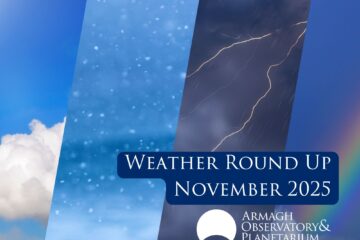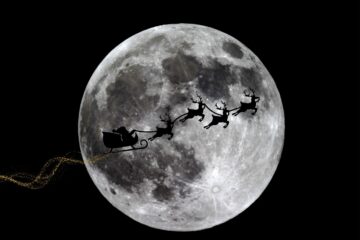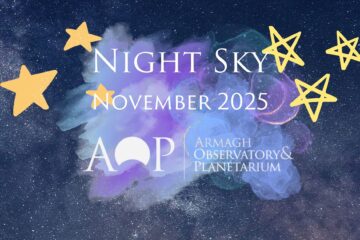It’s hard to believe that the summer has come around and we are half way through 2017. Time may be flying by but the good weather means a chance of clear skies at night and with lots to see this month let’s hope the rain stays at bay.

Jupiter and Saturn as seen in this month, looking south. Image credit: Samantha Rotherham, Stellarium
High in the sky this month it will be easy to spot Jupiter, a bright star-like object in the sky. However its brightness alone will catch the attention of any onlooker. As the biggest planet in our solar system this is a sight not to be missed, using a pair of binoculars or a telescope it is possible to spot some of Jupiter’s Galilean moons or even its features such as the Great Red Spot, a 300 year old storm on the surface. Saturn will be rising near the moon after 11pm this month and once again this is the direction to point your telescope, the ringed gas giant is an impressive site through any lens and with its prominent feature of rings, it’s a spectacular site or any stargazer.
Turning to the skies, the summer stars holds a Greek Legend and probably one of the most well-known individuals, Hercules. This constellation is the fifth largest in the sky but has no very bright stars, however it is distinct in shape as its central region looks like a flower pot and the entire constellation looks like a squished spider. In mythology the constellation of Hercules is associated with his twelve labours, the penultimate being to kill a dragon that guarded the garden of the Hesperides. In the night sky you can find this dragon in the form of Draco, a constellation dominant throughout the year due to its circumpolar position.
Hercules’ twelve labours were given to him by King Gurystheus, the first of which was to kill a Nemean Lion whose hide could not be pierced by any weapon. Hercules outsmarted the Lion and strangled it, afterwards using one of its claws to skin the beast and use its fur as a cloak and its open mouth as a helmet. For the next few weeks the constellation of Leo the Lion will be visible in the sky and it is easy to find with its head that looks like a sickle or backwards question mark.

Various constellations visible in the Summer skies this month. Image credit: Samantha Rotherham, Stellarium.
His second task was the defeat the many headed Hydra monster but as he fought the beast Hera sent a crab to distract him. Hercules killed the crab and it can be found as the constellation Cancer in the night sky. Hydra is the largest constellation in the night sky and a very difficult one to find due to it’s close proximity to the horizon and large size. Hercules had many tasks to complete which ranged from catching a deer with golden horns, a ferocious boar and even a bull that breathed fire so his position high up in the heavens is definitely well earned.
Just below Hercules you will spot the constellation of Ophiuchus, a man holding a snake represented by the constellation of Serpens.
Ophiuchus is one of the constellations that pass through the elliptic and there have been many attempts to include it in the signs of the zodiac however it does not belong to the zodiac family, though indeed it is the thirteenth constellation that the Sun passes through along the Ecliptic plane each year. The constellation is mostly compared to the Greek figure of Asclepius, son of the god of Apollo who was believed to be able to bring people back to life. Asclepius learnt this power from a snake after watching it bring a combination of herbs to another snake and bringing it back to life. This happened when Glaucus, the son of King Minos of Crete fell into a jar of honey and drowned. Asclepius saw a snake slithering towards his body and killed it, only then to witness another snake bring herbs to it and bring it back to life. Asclepius then tried this on Glaucus and the Kings son was miraculously resurrected.
Unfortunately it didn’t end well for Asclepius who was killed by Zeus because the god was worried that the human race would become immortal with Asclepius around to help them. Zeus’s brother Hades, the god of the Underworld was worried there the flow of dead souls into his domain would dry up also and after complaining to Zeus, the thunder god killed Ophiuchus with lightning bolt. However Asclepius’s good work did not go unnoticed and Zeus placed his image in the sky to honour his gift, it later became the constellation of Ophiuchus the healer holding Serpens the snake.
The early mornings will be bringing around Venus with the Moon towards the end of the month, however expect to see this very early in the morning from the 20th of June. It will be an easy planet to spot due to its bright appearance in the sky, not to mention a beautiful backdrop to the rising sun.
At the end of the month we have the summer solstice, a day that has the longest hours of sunlight due to the Earth’s tilt towards the Sun. It is the longest day of the year with the Sun set to rise at 04:52 and set again at 21.26, officially marking summer here in the UK. Although whether we get the weather to match is something we’ll have to wait and see.

Sunset captured by Scott Kelly onboard the International Space Station in 2015. Image Credit Scott Kelly, NASA.
There is plenty to see this month but just remember the summer may give us warmer weather but it does give us longer days, the sky will not be fully dark until closet to 11pm so sky watchers might need a bit of motivation to stay up into the early hours of the morning.
Article by Samantha Rotherham, Education Support Officer





0 Comments